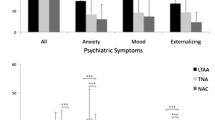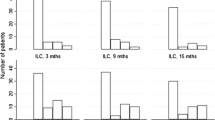Abstract
We sought to determine variables predictive of outcome in a group of 45 men with antisocial personality disorder followed up a mean of 29 years following hospitalization. Based on personal interviews, interviews with informants, and medical and legal records, sufficient information was available to rate the global outcome in 45 men. The Global Assessment Scale (GAS) was also used to measure functioning in 44 men at intake and follow-up. Twenty-six (57.8%) were rated as having “any improvement.” Univariate analysis showed men experiencing improvement were more likely to have high GAS scores at intake, were not currently alcoholic, were older, and were followed over a longer period of time. Low GAS scores at intake and the interaction between the GAS score at intake and current alcoholism independently predicted poor outcome on regression analysis. A low GAS score at intake and shorter follow-up also independently predicted poor outcome, even though stepwise regression revealed the strongest single predictor to be the interaction between the initial GAS score and age at follow-up. In summary, long-term outcome in antisocial males is associated with an initial level of severity, alcohol consumption at follow-up, and both age at follow-up and length of follow-up. Initial severity best predicts outcome among men not currently alcoholic who have been followed over a long period of time.
Similar content being viewed by others
REFERENCES
American Psychiatric Association: Diagnostic and Statistical Manual of Mental Disorders, Edition IV. Washington, DC: American Psychiatric Press; 1994
Robins LN, Helzer JE, Weissman MM, Orvaschel H, Gruenberg E, Burke JD: Lifetime prevalence of specific psychiatric disorders in three sites. Arch Gen Psychiatry 1984; 41:949–958
Robins LN: Epidemiology of antisocial personality disorder. In: Michels R, Cavenar JO, eds. Psychiatry, Vol. 3. Philadelphia; Lippincott; 1987;1–14
Goodwin D, Guze SB: Sociopathy (antisocial personality). In: Psychiatric Diagnosis, Edition 4. Oxford: Oxford University Press; 1989: 209–225
Guze SB: Criminality and Psychiatric Disorder. Oxford: Oxford University Press, 1976
Hare RD: Diagnosis of antisocial personality disorder in two prison populations. Am J Psychiatry 1983; 140:887–890
Mather DB: The role of antisocial personality in alcohol rehabilitation treatment effectiveness. Military Med 1987; 152:516–518
Woody GE, McLellan T, Luborsky L, O'Brien CP: Sociopathy and psychotherapy outcome. Arch Gen Psychiatry 1985; 42:1081–1086
Martin RL, Cloninger CR, Guze SB, Clayton PJ: Mortality in a follow-up of 500 psychiatric patients II. Cause-specific mortality. Arch Gen Psychiatry 1985; 42:58–70
Robins LN: Deviant Children Grown Up. Baltimore: Williams & Wilkins; 1966
Glueck S, Glueck E: Unraveling Juvenile Delinquency. Cambridge, MA: Harvard University Press; 1950
Sampson RJ, Laub JH: Crime in the Making—Pathways and Turning Points Through Life. Cambridge, MA: Harvard University Press; 1993
Luntz BK, Widom CS: Antisocial personality disorder in abused and neglected children grown up. Am J Psychiatry 1994; 151:670–674
Raine A, Venables PH, Williams M: Relationships between central and autonomic measures of arousal at age 15 years and criminality at age 24 years. Arch Gen Psychiatry 1990; 47:1003–1007
Hellman DS, Blackman N: Enuresis, firesetting and cruelty to animals: A triad predictive of adult crime. Am J Psychiatry 1966; 122:1431–1435
Raine A, Brennan P, Mednick SA: Birth complications combined with early maternal rejection at age 1 year predispose to violent crime at age 18 years. Arch Gen Psychiatry 1994; 51:984–988
Maddocks PD: A five-year follow-up of untreated psychopaths. Br J Psychiatry 1970; 116:511–515
Black DW, Baumgard CH, Bell SE: A 16-to 45-year follow up of 71 males with antisocial personality disorder. Comprehensive Psychiatry 1995; 36:130–140
Black DW, Baumgard CH, Bell SE: The long-term outcome of antisocial personality disorder compared with depression, schizophrenia, and surgical conditions. Bull Am Acad Psychiatry Law 1995; 23:43–51
Black, DW, Baumgard CH, Bell SE, Kao C: Death rates in 71 men with antisocial personality disorder. Psychosomatics 1996; 37:131–136
American Psychiatric Association: Diagnostic and Statistical Manual of Mental Disorders, Edition III. Washington, DC: American Psychiatric Press; 1980
Robins LN, Helzer JE, Croughan J, Ratcliff KS: National Institute of Mental Health Diagnostic Interview Schedule. Arch Gen Psychiatry 1981; 38:381–389
Endicott J, Spitzer RL, Fleiss JL, Cohen J: The Global Assessment Scale: A procedure for measuring overall severity of psychiatric disturbance. Arch Gen Psychiatry 1976; 33:766–771
Arboleda-Florez J, Holley HL: Antisocial burnout: An exploratory study. Bull Am Acad Psychiatry Law 1991; 19:173–183
Gibbens TCN, Pond DA, Stafford-Clark B: A follow-up study of criminal psychopaths. J Mental Sci 1959; 105:108–115
Martin RL, Cloninger CR, Guze SB: Female criminality and the prediction of recidivism—A prospective six-year follow-up. Arch Gen Psychiatry 1978; 35:207–214
Tong JE: Studies of the psychopathic offender. New Z Med J 1964; 63:103–107
Brown WK, Miller TP, Jenkins RL: The fallacy of radical nonintervention. Ann Clin Psychiatry 1989; 1:55–57
Henn FA, Bardwell R, Jenkins RL: Juvenile delinquents revisited—Adult criminal activity. Arch Gen Psychiatry 1980; 37:1160–1163
Zoccolillo M, Pickles A, Quinton D, Rutter M: The outcome of childhood conduct disorder. Psychol Med 1992; 22:971–986
Perry JC, Vaillant GE: Personality disorders. In: Kaplan HI, Freedman AN, Sadock BJ, eds. Comprehensive Textbook of Psychiatry, Volume II, Edition V. Baltimore, MD: Williams & Wilkins; 1989:1352–1395
Author information
Authors and Affiliations
Rights and permissions
About this article
Cite this article
Black, D.W., Monahan, P., Baumgard, C.H. et al. Predictors of Long-Term Outcome in 45 Men with Antisocial Personality Disorder. Ann Clin Psychiatry 9, 211–217 (1997). https://doi.org/10.1023/A:1022348225425
Issue Date:
DOI: https://doi.org/10.1023/A:1022348225425




